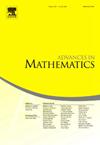具有拟周期初始数据的高维弱非线性Schrödinger方程
IF 1.5
1区 数学
Q1 MATHEMATICS
引用次数: 0
摘要
本文在Fourier空间的指数/多项式衰减条件下,证明了高维弱非线性Schrödinger方程的拟周期Cauchy问题的非线性解在一定时间尺度内渐近于相关的线性解。证明是基于一种组合分析方法,通过图表给出。我们的结果和方法适用于任意空间维度和形式为±|u|2pu的一般幂律非线性,其中1≤p∈N。本文章由计算机程序翻译,如有差异,请以英文原文为准。
The weakly nonlinear Schrödinger equation in higher dimensions with quasi-periodic initial data
In this paper, under the exponential/polynomial decay condition in Fourier space, we prove that the nonlinear solution to the quasi-periodic Cauchy problem for the weakly nonlinear Schrödinger equation in higher dimensions will asymptotically approach the associated linear solution within a specific time scale. The proof is based on a combinatorial analysis method presented through diagrams. Our results and methods apply to arbitrary space dimensions and general power-law nonlinearities of the form , where .
求助全文
通过发布文献求助,成功后即可免费获取论文全文。
去求助
来源期刊

Advances in Mathematics
数学-数学
CiteScore
2.80
自引率
5.90%
发文量
497
审稿时长
7.5 months
期刊介绍:
Emphasizing contributions that represent significant advances in all areas of pure mathematics, Advances in Mathematics provides research mathematicians with an effective medium for communicating important recent developments in their areas of specialization to colleagues and to scientists in related disciplines.
 求助内容:
求助内容: 应助结果提醒方式:
应助结果提醒方式:


